| |
THE 40 SCENES
The three parts of the Yuanmingyuan, as well as the Joyful Spring Garden that preceded them, were considered to be gardens, hence the term yuan. Each consisted of a number of complexes containing buildings of various types, artfully arranged in a “natural” setting that was carefully designed with lakes and streams; hills, bridges, and pathways; and pagodas and the like. Each complex was meant to create a separate vista, while blending into a diverse whole. Unlike European palaces, where the building was the central focus, in this Chinese paradise the buildings—practically all single-storied—were linked together, and formed just one part of the view. Altogether there were 650 “individually named structures” and 130 “formal views.” The total area was over 800 acres. [9]
Since all the Chinese buildings were made of wood, almost nothing remained of this vast paradise after the British and French troops set torch to the Yuanmingyuan in 1860. Virtually the only visual record of this imperial paradise is found in a set of paintings—the “40 Scenes” of the Yuanmingyuan—commissioned by the Qianlong emperor in 1744. Two court artists, Shen Yuan and Tangdai (a Manchu), and a calligrapher, Wang Youdun, undertook this work. The resulting album consisted of paintings on silk, one per page with calligraphy on the facing side. Each page measures 62.3 cm (24.5 inches) in height and width. Of the 40 Scenes, 12 were paintings of vistas newly created by Qianlong; the others were of sites created under Kangxi or Yongzheng. None of the buildings subsequent to 1744—in the Eternal Spring Garden (Changchunyuan) and Elegant Spring Garden (Qichunyuan)—are visually documented. The 40 Scenes were later copied into woodblock prints that were circulated among literati, but the original album was owned by the emperor himself. [10] In 1860, it was seized by French troops, taken back to France, and held at the Bibliothèque Nationale, where it remains to this day. It is deeply ironic and tragic that the French not only burned down the Yuanmingyuan but also stole the Emperor’s own visual record of it.
 |
| |
Selected scenes from Qianlong’s famous album follow here—some in full, some in detail—along with brief descriptions. The numbering corresponds to the sequencing in the original album of the 40 Scenes. The entire 40 Scenes are reproduced elsewhere in this unit. This is perhaps as close as one can now come to visualizing the “Garden of Perfect Brightness” through the eyes of its creators and admirers.
1. Main Audience Hall
Zhengda guangming 正大光明
Hall of Rectitude and Honor
The Main Audience Hall, designated the first of the 40 Scenes, was where the emperor received high officials and on a few occasions foreign guests. It was meant to resemble the main audience hall in the Forbidden City, the Hall of Supreme Harmony (Taihedian), but on a more intimate scale.
|
|
|
|
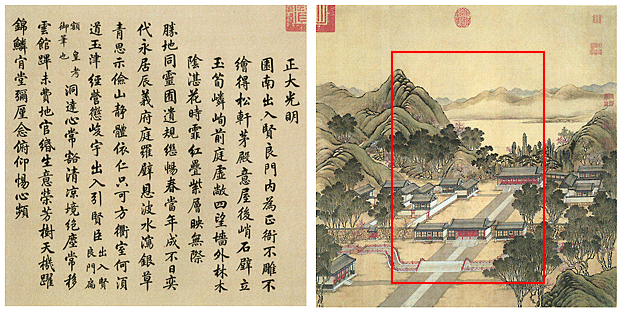 |
  After passing the main gate there was an inner courtyard with waiting chambers. The chambers of the Grand Council, the highest advisory body to the emperor, were located in this complex. Visitors then went over a stone bridge that crossed a moat. They then passed through a second gate that led to a courtyard with the audience hall that was ascended by three sets of steps. Instead of high walls and stone walkways, the Main Audience Hall, although enclosed, was surrounded by lovely trees and rolling hills. Banquets were served in this hall on special occasions.
After passing the main gate there was an inner courtyard with waiting chambers. The chambers of the Grand Council, the highest advisory body to the emperor, were located in this complex. Visitors then went over a stone bridge that crossed a moat. They then passed through a second gate that led to a courtyard with the audience hall that was ascended by three sets of steps. Instead of high walls and stone walkways, the Main Audience Hall, although enclosed, was surrounded by lovely trees and rolling hills. Banquets were served in this hall on special occasions.
Main Audience Hall
with detail and calligraphy
[ymy3006]
|
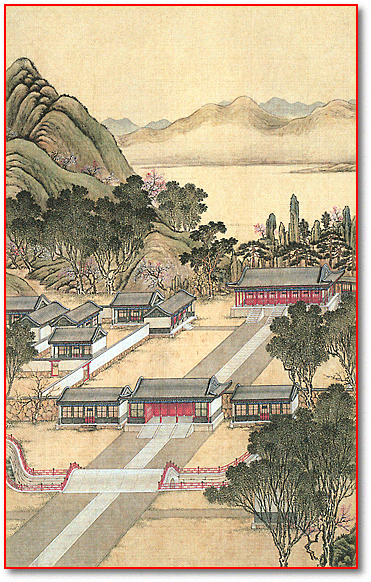 |
| |
| |
The calligraphy which faces on the left panel (books and scrolls in China unfold from right to left; on each page characters are written from top to bottom, and each line from right to left) first gives the name of the scene, here Zhengda guangming or Hall or Rectitude and Honor. These characters were written by the Yongzheng emperor and inscribed on a plaque at the gate to the complex. The same characters were also inscribed on plaques at the Forbidden City (the calligraphy by the Shunzhi emperor, Kangxi’s father), on Jing shan (Coal Mountain, with the calligraphy by the Kangxi emperor), and at the Mountain Resort to Escape the Heat at Chengde (the calligraphy by the Qianlong emperor). These words signify the righteousness and virtue of the Qing dynasty’s rule, and emphasize the Confucian aspect of their legitimacy. [11]
Following the name of the hall is an indented prose introduction to the Qianlong emperor’s grandiose poem about the hall, which is showcased in a larger format. The introduction states that this hall is the principal government building, located at the south side of the Yuanmingyuan, inside the Xianliang men (Gate of the Worthy and Upright). It is unadorned, without carving or painting, giving the appearance of a plain building made of pine and having a thatched roof. Beyond the hall are rugged and steep rocks and green bamboo thickets. In the front the courtyard is wide open, with vistas beyond the walls in all four directions. There are trees thick with foliage, and, in the spring, waves of red and purple flowers gleaming in endless succession.
The poem itself is in 20 lines of five characters each, in couplets rhymed with a continuous rhyme throughout. With allusive phrases, the emperor expands on the splendor and significance of the scenery and its inspiration for his reign. His rule will be frugal like the green of the foliage, and inspired by the serenity of the mountains, which are suffused with human spirit. After remarking on his deceased father’s calligraphy on the plaque above the gate leading to the hall, he resolves to govern with the diligence and perseverance symbolized by the construction of this building and garden. |
|
 |
| |
2. Hall of Diligent Government
Qinzheng qinxian 勤政親賢
Diligent and Talented Government
|
|
|
|
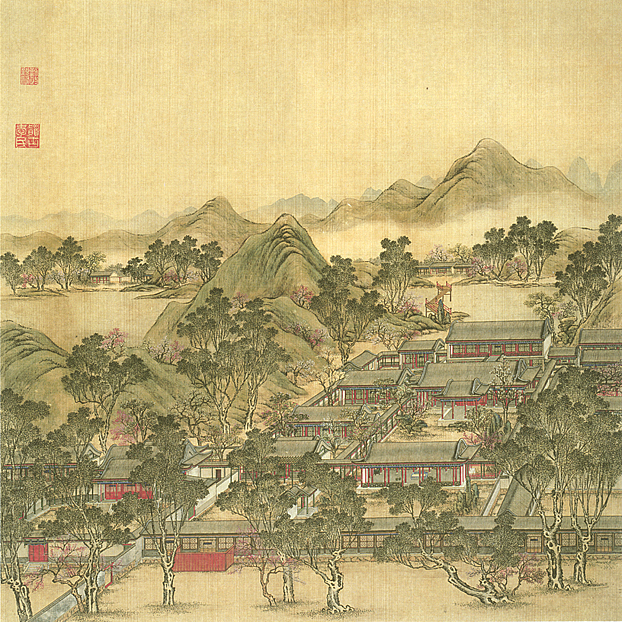 |
| |
[ymy1002]
Just to the east of the Main Audience Hall was the Hall of Diligent Government, which contained a small audience hall and many offices housing different government organizations. This was the emperor’s chief place of work, where he read documents and met with officials. On occasion he might hold discussions with scholars. [12] |
|
| |
 |
| |
3. Emperor’s Private Residence
Jiuzhou qing yan 九州清宴
Nine Continents Clear and Calm
|
|
|
|
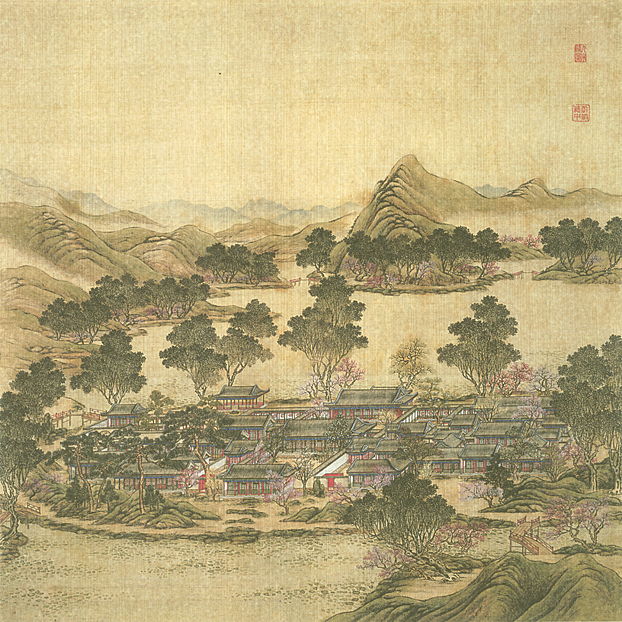 |
| |
[ymy1003]
To the north of the Main Audience Hall was the central complex of the Yuanmingyuan—designated by the Yongzheng emperor as the “Nine Continents Clear and Calm” because it consisted of nine islands surrounding the Back Lake or Houhu 後湖. This is where the emperor and his immediate family lived and took pleasure in the scenery. The various islands were connected by bridges. Each one was represented in the 40 Scenes (numbered 3 to 11). This third scene shows the emperor’s own residential quarters, and those of the imperial ladies. This island faced south to the Front Lake and back toward the Back Lake. It was densely covered with a series of one-story buildings, characteristic of northern style architecture; typically buildings were aligned along a north-south axis, with a central courtyard that was surrounded on four sides with other buildings. The various buildings were connected by walkways, usually covered. Privacy and intimacy were assured, and yet the private chambers were adjoined.
All the buildings were of secondary importance to the overall design of the gardens. What was valued was the natural but planned setting. Unlike Versailles or St Petersburg, the Yuanmingyuan was not dominated by a single grand palace, but a series of gardens into which the buildings were placed. When the emperors ordered or helped design a new section of the gardens, they imagined a perfect or exquisite view. The trees, shrubs, flowers, rocks, and ponds were all carefully juxtaposed. |
|
| |
 |
| |
4. Peony Terrace
Louyue kaiyun 鏤月開雲
Engraved Moon and Unfolding Clouds
|
|
|
|
| |
[ymy1004] Detail
The Peony Terrace occupied the island closest to the Emperor’s Private Residence. The various buildings were nestled into an exquisite garden featuring peonies. The Kangxi emperor observed ninety kinds of peonies blooming in the late spring.
The Qianlong emperor chose this setting to compose poetry, and in the poem accompanying this scene he recalls how when he was 12 sui (about 11 years) old his grandfather Kangxi visited him and his other grandsons there. On this occasion he took special interest in the upbringing of Qianlong, and may have decided to designate Qianlong’s father Yongzheng as the heir apparent so that Qianlong would eventually succeed to the throne. The painting in the 40 Scenes shows the hills and trees on this island, a microcosm of a perfect landscape. Qianlong titled this scene “Engraved Moon and Unfolding Clouds.” [13] |
|
| |
 |
| |
6. Green Wutong-Tree Academy
Bitong shuyuan 碧桐書院
Green Wutong-Tree Academy
|
|
|
|
| |
[ymy1006]
On this island, the emperor enjoyed listening to the sound of rain and composing poetry. Although named as an academy (shuyuan) several structures on this island were religious in function, including Daoist shrines and Buddhist temples. Another was a hall for worshipping the Dragon King and praying for rain. |
|
| |
 |
| |
7. Island of Shrines
Ciyun puhu 慈雲普護
Merciful Clouds Protect All
|
|
|
|
| |
[ymy1007] Detail
This island was shaped around a cove on the north side of the Back Lake. Grouped around the cove were a Buddhist temple and Daoist shrine, as well as a temple hall where Guanyin, goddess of mercy, and Guan Gong, a historical military hero, were both worshipped. Another hall was devoted to the Dragon King. Most striking was a Bell Tower, a three-tier pagoda structure, which appears to have a Western-style clock on one face. This religiously focused island thus reflects the religious and cultural eclecticism of the Qing emperors. |
|
| |
 |
| |
8. Island of Heavenly Light
Shangxia tianguang 上下天光
Heavenly Light Above and Below
|
|
|
|
| |
[ymy1008]
This view’s two-story main building facing the Back Lake was inspired by the Yueyang Lou (or Yueyang Tower) at the Dongting Lake in Hunan Province in central China, which was associated with a poem by the Song dynasty scholar Fan Zhongyan, among other writings. The structure in Hunan has been rebuilt several times and remains a favorite tourist spot.
In this scene, as in many others, the inspiration was provided by a landscape in the south of China that was celebrated by famous poets or painters from that region. (Scenes 23 and 39 below also evoke particular landscapes from the south.) [14] Kangxi may have seen some of these scenes, but the Qianlong emperor did not personally begin touring the south until 1757, seven years after the 40 Scenes were painted. |
|
| |
 |
| |
9. Apricot Blossom Spring Villa
Xinghua chunguan 杏花春館
Apricot Blossom Spring Villa
|
|
|
|
| |
[ymy2009] Detail
This island had the highest elevation in the Yuanmingyuan. The top of its hill commanded a grand view of the surrounding scenery. At the foot of the hill was the Apricot Blossom Villa. In this painting there are vegetable gardens and rustic dwellings in a village, a staged rural setting. Qianlong liked to come here when the flowers were in bloom, and in his poem he writes of drinking wine during a rainy night at the pavilion near the peak of the hill. |
|
| |
 |
| |
13. Universal Peace Building (Swastika House)
Wanfang anhe 万方安和
Peace and Harmony Everywhere
|
|
|
|
| |
[ymy1013] Detail
This island was dominated by a building in the shape of a Chinese character meaning Buddha’s heart 卍. It is pronounced wan, and is a homophone with another wan meaning ten thousand, or everywhere. Western observers in later times termed it the Swastika House. Built on a stone and brick foundation and surrounded by water and backed by a hill, this complex was “cool in the summer and warm in the winter.” [15] This was a favorite spot for evening strolls and watching the moon. |
|
| |
 |
| |
17. Ancestral Shrine
Hongci yonghu 鴻慈永祜
Vast Compassion and Eternal Blessing
|
|
|
|
| |
[ymy1017]
Located in the northwest corner of the Yuanmingyuan, the two- and three-story Ancestral Shrine, built partly of stone and marble, was more formal and imposing than other religious buildings. Qianlong called the view of it “Vast Compassion and Eternal Blessing.”
The approach to the shrine was across five marble bridges that spanned a moat. There were multiple marble columns with elaborate decoration, and the interior of the shrine was also well ornamented. Inside the shrine were portraits and tablets commemorating the deceased emperors. The entire complex was surrounded by outer and inner walls painted red and having glazed tiled roofs. Because it was constructed with stone and marble, some elements of the structures survived the 1860 torching of the Yuanmingyuan. [16] |
|
| |
 |
| |
23. Scholar Lianxi’s Wonderland
Lianxi lechu 濂溪樂處
Happy Place of Lianxi
|
|
|
|
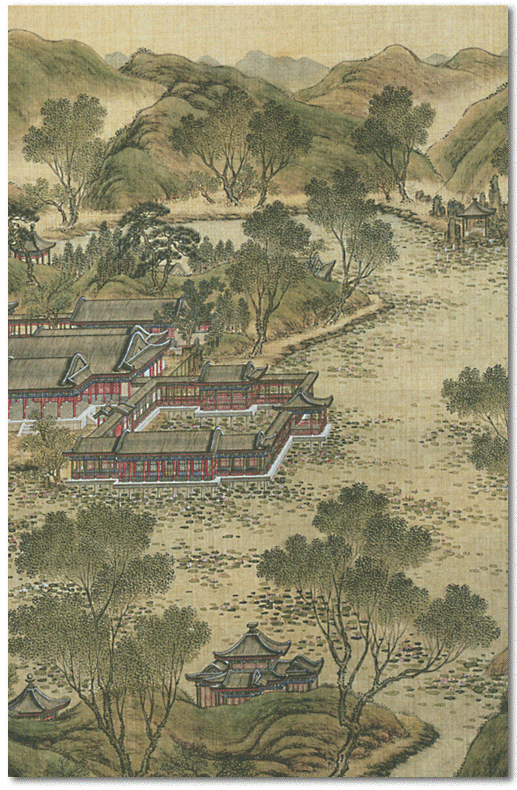 |
| |
[ymy1023] Detail
This extensive and lovely scene contained a variety of halls, pavilions, and bridges, suspended over a large lotus pond. The lotus had a special meaning in Chinese culture and religion, symbolizing purity as it rose each day above the mud of the pond. The Song philosopher Zhou Dunyi (Zhou Lianxi, 1017–1073) wrote the following in “Love of the Lotus Flower”: I especially love the lotus, which grows out of the dirty mud yet is clean, cleansed by the pure waters but not seductive; its center is void, thus the lotus has vacuity; it grows straight and has no creeping vines and branches; its fragrance is milder in the distance, its stem is erect, slim and clean; it is to be enjoyed from a distance but not too intimately.
Admiring scholars, and appreciating the comparison between them and the lotus, the Qianlong emperor named this favorite scene “Lianxi’s happy place,” Lianxi being the studio name of Zhou Dunyi, who lived near the West Lake in Hangzhou. In his accompanying poem, the emperor wrote of the beauty of this famous place and its association with the loftiest scholarship.[17] |
|
| |
 |
| |
29. Beautiful Scene of the Square Pot
Fanghu shengjing 方壺勝景
Beautiful Scene of the Square Pot
|
|
|
|
| |
[ymy1029]
To the east of the Nine Continents original section of the Yuanmingyuan, the Qianlong emperor developed another section that surrounded the Fuhai 福海, or the Sea of Blessing. “The Beautiful Scene of the Square Pot” was a whimsical title for Scene 29, which comprised the largest and most elaborate complex in the perimeter of the Sea of Blessing.
Its spacious two-story halls and surrounding pavilions, twelve major structures in all, were decorated with gold glazed tile roofs, while the buildings were painted deep red with green, blue and white decoration, contrasting with the white marble balustrades. The entire structure rested on a terraced edifice, and was conceived on a larger scale than the earlier structures on the Nine Continents. |
|
| |
 |
| |
32. Jade Terrace of Paradise Island
Pengdao yaotai 蓬島瑤臺
Jade Terrace of Paradise Island
|
|
|
|
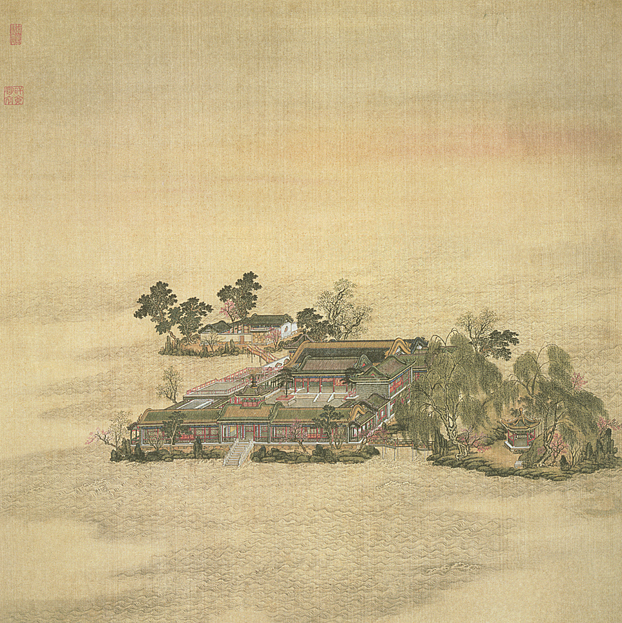 |
| |
[ymy1032]
This diminutive islet, actually three small linked islands, rested at the middle of the Sea of Blessing. Its design was based on a fairy tale by a Tang dynasty artist Li Sixun (651-716). Although compact, the main island had some dozen chambers for viewing scenery and even for performance of Buddhist and Daoist rituals. The emperors Yongzheng and Qianlong enjoyed watching displays and performances there. The view from the Jade Terrace was apparently exquisite. The Jesuit Attiret, who was privileged to accompany some imperial boating excursions, described it in this way:
From it you have a view of all the palaces, scattered at proper distances round the shores of this sea; all the hills, that terminate about it; all the rivulets, which tend thither, either to discharge their waters into it, or to receive them from it; all the bridges, either at the mouths or ends of these rivulets; all the pavilions and triumphal arches, that adorn any of these bridges; and all the groves, that are planted to separate and screen the different palaces, and to prevent the Inhabitants of them from being overlooked by one another. [18] |
|
| |
 |
| |
34. Another Cave of Heaven
Bieyou dongtian 別有洞天
There is Another Cave of Heaven
|
|
|
|
| |
[ymy1034] Detail
At the southeast corner of the Sea of Blessing area was a site described as a Cave of Heaven, or “the Other Paradise.” In addition to major structures for contemplation or worship, there were cottages and villas. This is the only one of the 40 Scenes that shows a specifically winter view. |
|
| |
 |
| |
38. Market Street at
“Sitting Rocks and Winding Stream”
Zuoshi linliu 坐石臨流
Sitting Rocks and the Winding Stream
|
|
|
|
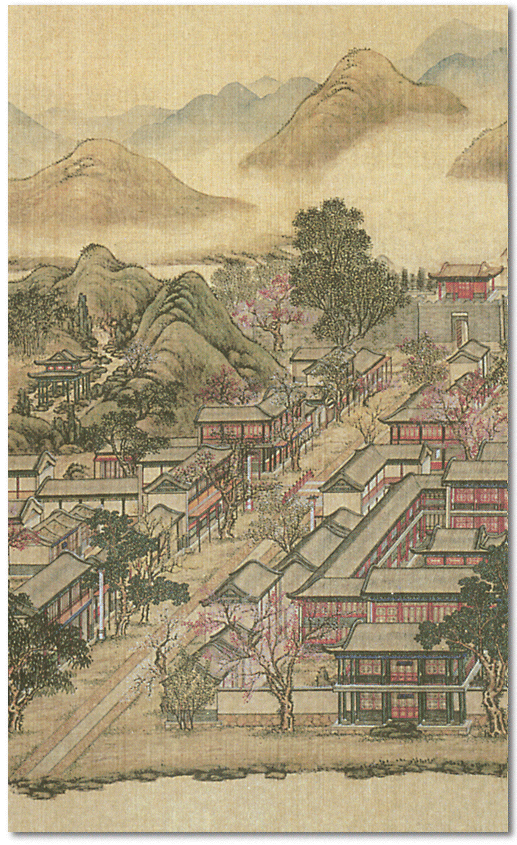 |
| |
[ymy1038] Detail
Circling back to the area just northeast of the Nine Continents was a complex called Sitting Rocks and Winding Stream. It had diverse functions and features. It included the All-Happy Garden, where the emperor frequently dined. There was also an Orchid Pavilion, modeled on one of the same name in Shaoxing, in the Jiangnan area, where famous scholars practiced calligraphy and composed poems while drinking and admiring the scenery. A theater provided another favorite recreation.
The street depicted here ended at the Sheweicheng, a stone gate named for an Indian city associated with the Buddha. (Sheweicheng is a translation of the Indian term Sravasti. Some English-language books on the Yuanmingyuan refer to this scene as “the Wall of Sravasti.”) Here as elsewhere, the emperor’s appreciation of a scene at the Yuanmingyuan depended greatly on its association with an important literary allusion.
The famous market street was located here, with shops that provided the court ladies an opportunity to pretend to be ordinary people out shopping. The eunuchs also pretended to be commoners, particularly relishing roles as merchants, rudely hawking their goods and trying to attract customers. They also played the roles of artisans, officers, soldiers, porters, and other ordinary folk. There were entertainments and everything else a real town would have. [19] |
|
| |
 |
| |
39. Bridge at the “Distillery and Lotus Pond”
Quyuan fenghe 麴院風荷
Distillery and Lotus Pond
|
|
|
|
| |
[ymy1039]
Modeled after a view from the famous West Lake in Hangzhou, “Yeast Courtyard, Wind, and Lotus” referred to a place where liquor was made. [20] Its main feature was a bridge of nine arches, a classical design, spanning a lotus pond.
The Chinese title of this scene involves a play on words. Quyuan written one way (麴院) means distillery; written another way (曲院) it means curving or curved. Hence the discrepancy in the ways the title of this scene is translated in English (Yeast Courtyard and Lotus Pond, or Curving Courtyard and Lotus Pond). |
|
| |
 |
| |
40. The Princes’ School
Dongtian shenchu 洞天深處
Deep Vault of Heaven
|
|
|
|
| |
[ymy1040]
The last of the 40 Scenes returns us to a southeast corner of the original Yuanmingyuan, close to the main gate and audience hall. These barrack-like buildings housed the school where the young princes were educated as well as the dormitories where they lived. When he was still the crown prince, the Qianlong emperor had his private and more elegant quarters at the other side of this complex.
The calligraphy at the lower left of the painting states: “In the ninth month of the ninth year of the Qianlong reign [1744], we humble servants Tangdai and Shen Yuan respectfully present these paintings, having received the imperial order.” The signature at the bottom left of the facing page of calligraphy (not shown here) states: “The minister of the Board of Works, your humble servant Wang Youdun, humbly submits this calligraphy according to the imperial order.”
|
|
|





